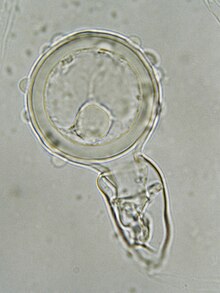Phytophthora cambivora
| Phytophthora cambivora | |
|---|---|

| |
| Scientific classification | |
| Domain: | Eukaryota |
| Clade: | Diaphoretickes |
| Clade: | SAR |
| Clade: | Stramenopiles |
| Phylum: | Oomycota |
| Order: | Peronosporales |
| Family: | Peronosporaceae |
| Genus: | Phytophthora |
| Species: | P. × cambivora
|
| Binomial name | |
| Phytophthora × cambivora | |
| Synonyms | |
| |

Phytophthora × cambivora is a plant pathogen that causes ink disease in European chestnut trees (Castanea sativa). Ink disease, also caused by Phytophthora cinnamomi, is thought to have been present in Europe since the 18th century, and causes chestnut trees to wilt and die; major epidemics occurred during the 19th and 20th centuries. P. cinnamomi and P. × cambivora are now present throughout Europe since the 1990s. Ink disease has resurged, often causing high mortality of trees, particularly in Portugal, Italy, and France.[1] It has also been isolated from a number of different species since the 1990s, including:
- Golden chinquapin trees, (Chrysolepis chrysophylla) in Oregon, United States[2]
- Rhododendron and Pieris species in North Carolina[3]
- Noble fir trees (Abies procera) in Norway[4]
- Beech trees (Fagus sylvatica) in Italy[5] and Germany.[6]
Some species of mycorrhiza (including Amanita muscaria, Suillellus luridus, and Hebeloma radicosum) may provide protection from P. cambivora in European chestnuts.[7]
Phytophthora × cambivora is a hybrid.[8]
See also[edit]
References[edit]
- ^ Robin, Cécile; Olivier Morel; Anna-Maria Vettraino; Charikleia Perlerou; Stephanos Diamandis; Andrea Vannini (1 May 2006). "Genetic variation in susceptibility to Phytophthora cambivora in European chestnut (Castanea sativa)". Forest Ecology and Management. 226 (1–3): 199–207. doi:10.1016/j.foreco.2006.01.035.
- ^ Saavedra, A; E. M. Hansen; D. J. Goheen (19 November 2007). "Phytophthora cambivora in Oregon and its pathogenicity to Chrysolepis chrysophylla". Forest Pathology. 37 (6): 409–419. doi:10.1111/j.1439-0329.2007.00515.x. Archived from the original on 5 January 2013. Retrieved 9 July 2009.
- ^ Hwang, J; Warfield, CY; Benson, DM (June 2006). "Phytophthora cambivora, a new dieback pathogen of Rhododendron and Pieris in North Carolina". Phytopathology. 96 (6): supplement pages 185–186. Archived from the original on 7 March 2012. Retrieved 9 July 2009.
- ^ Talgø, V; M. Herrero; B. Toppe; S. Klemsdal; A. Stensvand (May 2006). "First Report of Root Rot and Stem Canker Caused by Phytophthora cambivora on Noble Fir (Abies procera) for Bough Production in Norway". Plant Disease. 90 (5): 682. doi:10.1094/PD-90-0682B. PMID 30781155.
- ^ Belisario, A; M. Maccaroni; M. Vettorazzo (October 2006). "First Report of Phytophthora cambivora Causing Bleeding Cankers and Dieback on Beech (Fagus sylvatica) in Italy". Plant Disease. 90 (10): 1362. doi:10.1094/PD-90-1362C. PMID 30780960.
- ^ Hartmann, G; Blank, R; Kunca, A. "Collar rot of Fagus sylvatica caused by Phytophthora cambivora - type of damage, endangered sites and susceptible hosts in Northwestern Germany".
{{cite journal}}: Cite journal requires|journal=(help) - ^ Landi, L; Mosca, M; Branzanti, M.B. (27–29 March 2006). "Interactions between mycorrhizic fungi and Phytophthora cambivora agent of ink disease in chestnut [Castanea sativa Mill.]". Italian Plant Protection Association. Biennial Meeting. Retrieved 9 July 2009.[permanent dead link]
- ^ Jung, T.; Pérez-Sierra, A.; Durán, A.; Jung, M. Horta; Balci, Y.; Scanu, B. (2018). "Canker and decline diseases caused by soil- and airborne Phytophthora species in forests and woodlands". Persoonia – Molecular Phylogeny and Evolution of Fungi. 40: 182–220. doi:10.3767/persoonia.2018.40.08. PMC 6146643. PMID 30505001. S2CID 54167832. Yang, Xiao; Tyler, Brett M.; Hong, Chuanxue (2017). "An expanded phylogeny for the genus Phytophthora". IMA Fungus. 8 (2): 355–384. doi:10.5598/imafungus.2017.08.02.09. PMC 5729717. PMID 29242780. S2CID 9386776. These reviews cite this research. Jung, T.; Jung, M.H.; Scanu, B.; Seress, D.; Kovács, G.M.; Maia, C.; Pérez-Sierra, A.; Chang, T.-T.; Chandelier, A.; Heungens, K.; Van Poucke, K.; Abad-Campos, P.; Léon, M.; Cacciola, S.O.; Bakonyi, J. (2017). "Six new Phytophthora species from ITS Clade 7a including two sexually functional heterothallic hybrid species detected in natural ecosystems in Taiwan". Persoonia – Molecular Phylogeny and Evolution of Fungi. 38: 100–135. doi:10.3767/003158517X693615. PMC 5645180. PMID 29151629. S2CID 12341727.
